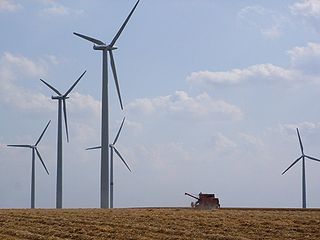From Guest Blogger Tina Samuels: Wind Energy Isn't All Hot Air
Confused about some of the facts on wind energy? Does it work as well as they say?
There are tremendous benefits for having wind energy, and here are some of the top facts on the productivity of it.
Number One in New Generating Capacity
In 2012, wind energy was the number one electricity-generating capacity source for the first time ever. It provided, all total, 42 percent of the new electricity-generating capacity for all sources. U.S. developers are installing nearly two turbines a week with the current rate of growth.
It’s Growing Far and Wide
New wind energy installations in the United States for the last quarter of 2012 was led by Texas, with California, Kansas, Iowa, and Oklahoma not being far behind. Texas put in a whopping 1,289 megawatts. Worldwide, Germany led the race, with Spain, the US, India, and Denmark not far behind.
Interesting Bit Facts
These facts are short and sweet, but very interesting in the scope of renewable energy:
-
25 percent of the energy in Texas is, at times, produced solely by wind energy.
-
Wind power in the United States equals 10 nuclear power plants and is a $10 billion/year industry.
-
Wind energy uses nearly no water as it powers. This could save 30 trillion bottles of water in the United States along by the year 2030.
-
One turbine has enough power capability to be used by 500 homes.
-
The windmill has been around since 2000 BC and is the fast-growing electricity source in the world today.
-
There is enough wind in the United States to power the country, and have 9 times the energy left over.
Turbine Size
Wind energy turbines are typically as high as a 20 story building with three 60 meter long blades, roughly 200 feet long. These blades will spin a shaft that is connected to a generator. This spinning produces electricity. Some are on vertical axis with the blades looking more like an egg beater than an airplane propeller.
The Pollution Factor
With the use of wind turbines to harness power, there is no water or air pollution from the production of that power. Wind is a free energy source, so the only out of pocket expense is from the erection of the turbine. While these turbines are getting cheaper as the technology advances, government is also helping by having more and more tax incentives to help offset the cost of having a wind energy development built.
As you can see, wind energy is a very real way to have a cleaner, eco-friendly, energy source.
It works well, can be the answer for man’s fossil-fuel obsession, and is feasible in any town or location.
About the Author: Tina Samuels writes for a number of different business sites, including Reputation.com.


I would mostly agree with you except that there are some locations where typical wind speeds are too low to make wind farms economically justifiable. This is not however a problem, as there are plenty of places where wind is both technically viable and financially attractive.
Even intermittency is less of an issue than is made out as wide geographical dispersion of turbines usually means that the wind is blowing somewhere, and with modern forecasting techniques, change in wind power generation over time as weather systems go by is reasonably accurate with predictions mostly allowing other generators time to ramp power production up or down so that less extra spinning reserve is needed than commonly supposed.